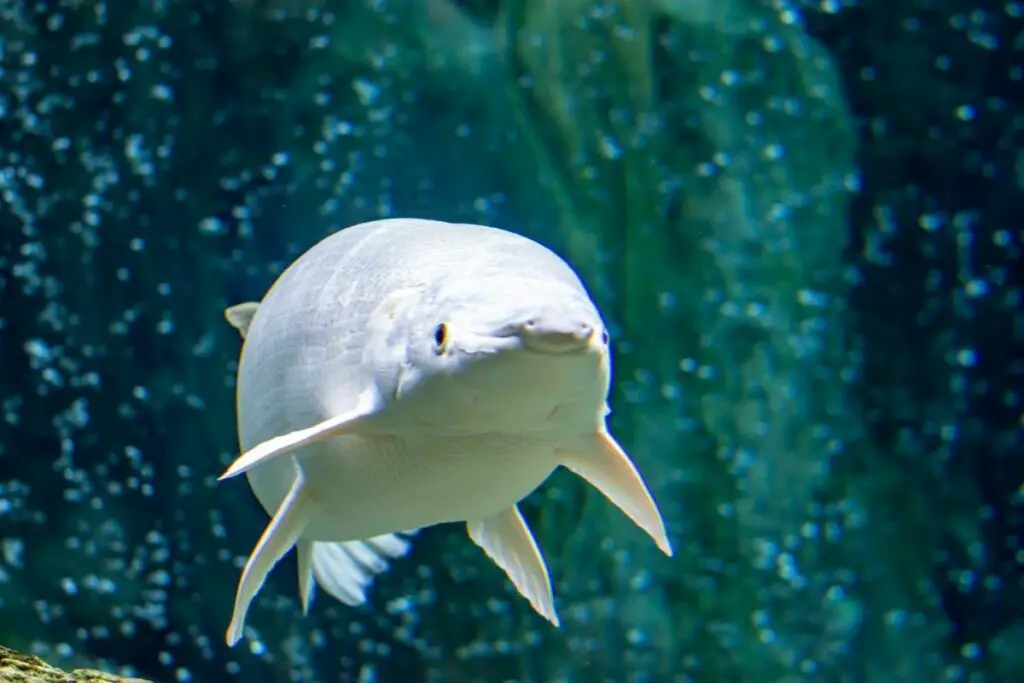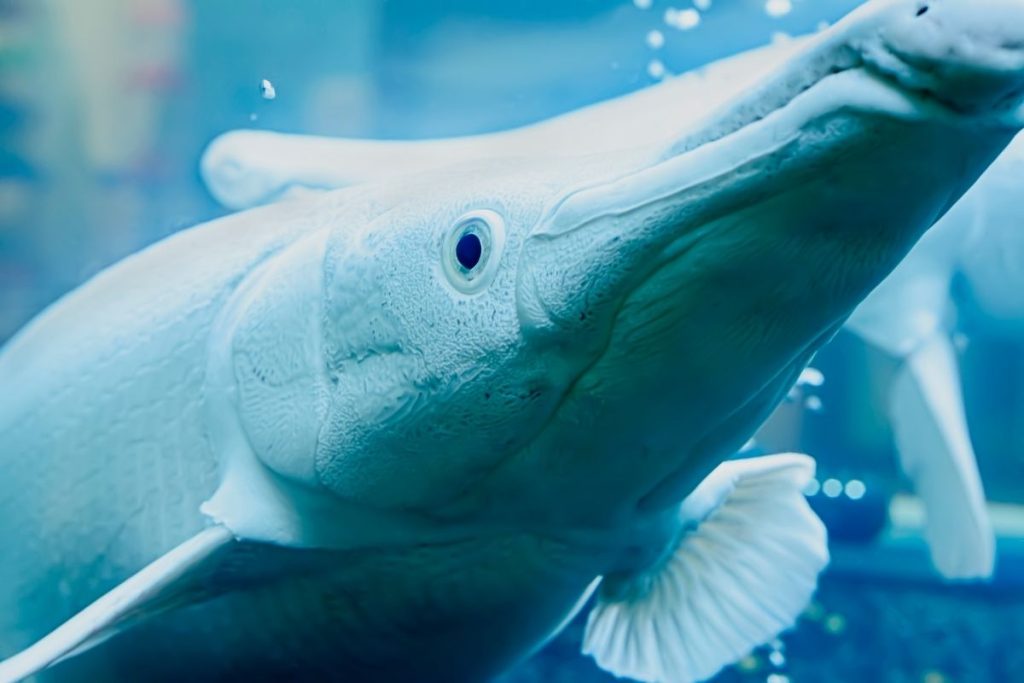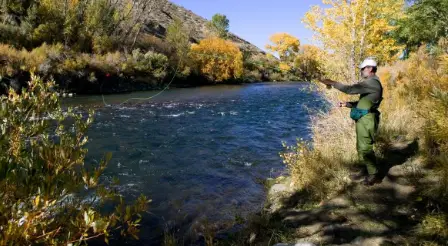An alligator gar is a pretty impressive and daunting specimen for anglers. They are one of the largest freshwater fish you can find, and weigh a serious amount, making them particularly sought after by both ichthyologists and anglers alike.
As the alligator gar can date back over 100 million years ago they are often referred to as ‘living fossils’ or ‘primitive fishes’ only adding to their mystique.
What Is An Alligator Gar?
The alligator gar is an euryhaline fish, meaning it can adapt to many different saline waters. In America, the alligator gar remains one of the largest freshwater fish you can catch. Most mature specimens can measure around 6 feet, although anecdotal evidence suggests they could potentially reach 10 feet.
Historical Record
Their fossil records can date back as far as the Cretaceous period which is around 100 million years ago. As their evolution was in its mature stages, they could easily exist a while before this. This suggests the alligator gar is essentially as old as the dinosaurs, specimens such as triceratops and pterosaurs date back to the same period.
Morphology
The alligator gar has a very long, usually brown body. The body is covered in ganoid scales, unlike most other common fish scales.
These ganoid scales are almost impenetrable and date back to the Cretaceous period so aren’t that common on other fish. These scales are near impenetrable, making them very protected against predators as well as others of their own species.
What differentiates them from other species of gar, is that their upper jaw has a dual row of teeth that are very sharp and have evolved to keep prey stuck in their jaws.
The alligator gar is a serious predator within their own environment and often stalks or ambushes prey such as waterfowl or even small mammals they find on the water’s surface. Yet, an alligator gar will remain peaceful with humans.
The head of the alligator gar is where it gets its name. The head is relatively flat with an elongated mouth. This snout somewhat resembles the American alligator, and the two are likely to inhabit similar environments within the US.
Thanks to their prehistoric ancestors the alligator gar also has a spiral valve intestine similar to a shark’s, which allows the alligator gar to breathe both air and water. Their heads often surface in the shallower waters
Distribution
Historically, the alligator gar lives across the Americas reaching far North where in modern distribution they are rarely found. The main distribution of alligator gar in the USA today is across the southern states, within the Mississippi River Valleys and Gulf Coast states. Even found as far south as Veracruz in Mexico.
Many ichthyologists would suggest the current distribution of alligator gar can be referred to as extirpated. Extirpation refers to a species which is considered extinct within its natural environment, but still exists elsewhere.
This is mainly due to human intervention, although interestingly, this has little to do with overfishing as alligator gar are so hard to catch. Instead what occurred was a lot of habitat destruction within the North of America as a result of building as well as indiscriminate culling.
Until the 1980s the alligator gar was considered extremely dangerous and a nuisance species which affected game fish. As the alligator gar is a predator it will kill most fish that people may commonly catch in North America such as salmon or tuna. More modern understanding of the ecosystem led this to change for the better.
If the alligator gar was not an euryhaline fish, it likely would not have such a strong population as it does today. This allowed the alligator gar to migrate to the waters of the South such as the bracklands, swamps and marshes that are common in Southern states.
How To Catch Alligator Gar?
It can be particularly hard to catch the alligator gar as their size and weight often exceeds that of a human. Physics often leads to anglers using extra tools and methods in order to overcome these issues.
Lethal Capture
One main issue is that a large J hook is often needed in order to catch and lift an alligator gar, especially the large specimens.
While this can work this could lead to killing the gar quite easily. This means ethical catch and release of alligator gar can be particularly hard without killing the fish.
Beyond this issue, a rod and reel setup requires some serious angling experience to successfully catch these massive fish.
Yet, there have been recorded success of catching alligator gar with nearly every angling method. But you will have to be seriously proficient to do so. It’s very likely these methods led to the death of the fish.
The most common set up is the aforementioned J hook. Sizes under 4/0 are less likely to kill the fish but can still be lethal. A strong braided line is connected to a steel leader, potentially with a weight to take it to the bottom of the river.
As alligator gar are large fish, the larger the bait the better. Commonly, people use carps that alligator gar love.
Ethical Capture and Release

Tyger Leader is reader-supported and may earn a commission when you book or purchase using our links. Learn more about our affiliate disclaimer here.
Ethical capture and release of the alligator gar is largely encouraged to keep populations high, but this can be particularly hard. Moreover without an effective method of ethical capture and release, many alligator gar will potentially die through lack of success.
Firstly, to ensure the highest chance of survival, the large J hook needs to penetrate the gar’s mouth. This is particularly hard as the gar has large teeth and a very cartilaginous upper jaw which is hard to penetrate.
If you can penetrate the jaw successfully, you then need to remove the large hook without killing the fish. In order to successfully get the hook out without harming yourself or the fish, you may need to invest in thick gloves and also needle nose pliers.
A thick stick or something similar can be used to keep the gar’s mouth open for easy extraction.
Your other option can perhaps lead to higher success but requires some more specific angling tools. Using the same set-up with a hook, leader, and strong fishing line, the angler can let the gar digest the bait before hooking them.
A gar is likely to pick up bait in their jaws and they usually travel a little further to actually eat and digest the bait. If you use a non-stainless steel hook such as this one, you can easily hook the alligator gar from the inside out.
Once the gar is in your hands you can cut the leader, which should also be non-stainless steel, the alligator gar should be able to digest the leader and hook with ease, living to fight another day.
One tip is to fish on the shore rather than on a boat. The use of lassos or snares to get the alligator gar over the ship’s hull can often cause damage to the fish that is fatal. Shoring the fish on the shore is much safer for them.
Final Thoughts
The alligator gar is certainly one of the most interesting fish species out there, especially within USA waters. Their popularity is spread among ichthyologists and anglers alike.
The sheer size of the gar is enough to inspire awe in anyone’s eyes. Their size and weight can be hard to believe and makes them particularly interesting to the anglers of the world. To catch an alligator gar is a true angling feat.
Catching alligator gar without killing them is highly recommended but also increasingly hard. Large hooks and apparatus are needed to deal with the weight of the fish which is often deadly to the alligator gar when not done properly.
Finding the most effective and safe method for ethically capturing and releasing an alligator gar is very hard and still not known.
For ethical capture and release the most recommended method is to use non-stainless-steel hooks and leaders which the alligator gar can digest and shed.
The alligator gar is an extremely prehistoric fish that can date back as far as the Jurassic era. For this reason alone the population of the fish should be kept high in order for ichthyologists to study the fish. Yet, for these same reasons there is a lot of allure in catching the fish.
Unfortunately, the more people who fish the alligator gar, with ethical release in mind or not, will ultimately lead to a lot more deaths of the alligator gar, accidentally or purposefully.
We should always err on the side of caution and only fish this specimen animal when effective capture and release methods have been established and have a low chance of death.



